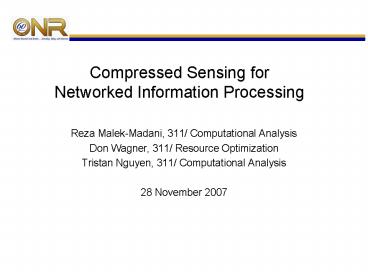Compressed Sensing for Networked Information Processing - PowerPoint PPT Presentation
1 / 15
Title:
Compressed Sensing for Networked Information Processing
Description:
'Measure' the signal via a random projection to yield a compact representation. Reconstruct the signal from its compact representation. Nyquist vs. Compressed Sensing ... – PowerPoint PPT presentation
Number of Views:126
Avg rating:3.0/5.0
Title: Compressed Sensing for Networked Information Processing
1
Compressed Sensing for Networked Information
Processing
- Reza Malek-Madani, 311/ Computational Analysis
- Don Wagner, 311/ Resource Optimization
- Tristan Nguyen, 311/ Computational Analysis
- 28 November 2007
2
Ubiquitous Compressibility
- DoD acquires and uses huge amount of data
- In many scenarios, most of the data in a signal
can be discarded with almost no perceptual loss - E.g., lossy compression formats for sounds and
images - Key Questions
- Why acquire all the data when most will be
discarded? - Can we directly measure the relevant information?
- Challenge Develop mathematical and
computational techniques that allow us to
directly acquire relevant information from
signals and images in compressed form. - Key Words Adaptivity, Parallelization,
Stability, Nonlinearity, Noise
3
What is Compressed Sensing?
- Underlying Assumption Most signals are
compressible in some representation (i.e., most
coefficients are small relative to some basis) - Compressed Sensing
- Measure the signal via a random projection to
yield a compact representation - Reconstruct the signal from its compact
representation
4
Nyquist vs. Compressed Sensing
- Nyquist rate samples of wideband signal (sum of
20 wavelets) - N 1024 samples/second
- Reconstruction from compressed sensing
- M 150 random measurements/second
MSE lt 2 of signal energy
5
Nyquist vs. Compressed Sensing
- Nyquist rate samples of image
- N 65536 pixels
- Reconstruction from compressed sensing
- M 20000 projections
MSE lt 3 of signal energy
6
Compressed Sensing
- Forward Problem Random projection is the key
idea - Inverse Problem Reconstruct from this
is an ill-posed problem
Candes-Romberg-Tao, Donoho, 2004
7
CS Signal Recovery
- Reconstruction find given
- Classical L2 approach
- L2 algorithm is fast, but unfortunately it is
wrong
8
CS Signal Recovery
- Reconstruction given(ill-posed inverse
problem) find - L2 fast, wrong
- L0 correct, slow
- L1 correct, mild oversampling Candes et al,
Donoho
Linear-programming problem
9
Theoretical Result (Donoho, 2004)
- Theorem There is a function g, from the
interval (0, 1 to itself, with the following
characteristics - Fix e gt 0.
- If K/M gt g(M/N)(1 e) then, with overwhelming
probability for large N, - .
- If K/M lt g(M/N)(1 e ), then does not
equal .
10
Applications
- Image Understanding (feature detection)
- Communication
- Underwater Communication (RF)
- Wireless Communication
- Channel Parameter Identification (cognitive
radio, radar) - Distributed Sensing (fusion of partial
information) - .
11
Mathematical Challenges
- Randomness versus determinism
- Can random sensing matrices be replaced by
deterministic ones? - What is the impact on the theoretical
development? - Can rigorous bounds be developed for the
equivalents of K, M and N? - Faster optimization algorithms
- Reconstruction via L1 minimization is relatively
slow - Other algorithmic ideas need to be developed
- First-order vs. second-order methods?
- Combinatorial vs. linear vs. nonlinear methods?
- Need to create baselines for comparing algorithms
in terms of reconstruction speed and accuracy - Multiple sensors/multiple targets
- Can the underlying theory be extended to handle
distributed, networked sensors and multiple
targets? - Develop the mathematical tools needed to take
advantage of the statistical correlations among
signals to perform multi-signal reconstruction
12
Mathematical Challenges
- How many measurements are needed?
- One can get by with much fewer measurements, but
at the expense of having to solve a tougher
(i.e., non-convex) optimization problem. What is
the tradeoff? - Important extensions needed
- No development to date of distributed
reconstruction algorithms - Very important for distributed sensor networks
- Does the theoretical developments to date
adequately address the issue of noise? - Random vs. pseudo-random vs. deterministic
sensing matrices
13
Tangential Issues
- Extension of compressed-sensing optimization to
affine rank minimization - Potentially very important in data mining
- Numerical partial differential equation solvers
- Can de-aliasing techniques benefit from the
compressed-sensing approach?
14
Budget
- Current seed investment 250K/year
- Proposed First Year 1.2M/year
- 40 for analytical/theoretical development
- 40 for algorithmic/computational development
- 20 for application/sensor development
- Outyear growth towards applications
15
Summary
- Compressed Sensing is an important emerging area
- Cuts across of sciences and engineering
- Pioneering foundations are in place
- ONR is well positioned to be a leader































